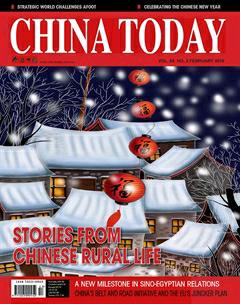Rime Island – Wonderland of Frost and Ice
By WEI YAO
Rime Island – Wonderland of Frost and Ice
By WEI YAO

January scenery on Rime Island.
U P to two years ago, Chao Guixian, an ordinary 48-year-old farm er in J ilin Province, spent most of her time tilling her cornfield. But the cold weather due to the high latitude here halts the growth of almost everything when November breaks. At this time of the year, Chao formerly had little better to do than hunker down at home and wait for the following May, when she would begin a new year’s work in the fields.
Life still proceeds like this for most denizens of rural areas in China’s Northeast. More fortunate than most farmers in the region, however, Chao lives in Zengtong Village, or “Rime Island,”which is storied for its beautiful winter scenery. For Chao, it has been lifechanging.
Set in the Songhua River in the northern suburbs of Jilin City of Jilin Province, Rime Island is renowned for its surreally-frosted, arboreal winter landscape. Hoarfrost is a natural phenomenon of the Northeast China winter, which starts in mid-November. A result of moisture from the Songhua River interacting with cold air, ice rime forms frequently in this area, especially during heavy snowfalls accompanied by freezing temperatures.
In Jilin, gazing the ice-rimed trees has become almost routine for the people. At this season, the local TV station broadcasts a daily “hoarcast” to inform when is the best time to stroll down to the Songhua River and look at the iceladen trees.
Rime Island is where hoarfrost most frequently forms. Situated on flat land surrounded by water, the island lies downstream from a reservoir, from which relatively warmer water flows in. In winter, the fog is so dense that it usually envelops the six-sq-km island. In such weather, the ice rime burdening the boughs does not break or fall, but receives a second coating during the night. By the next morning, the projecting icicles may have swollen to the size of an adult’s arm.


A normal family inn in Hantun Village.

The local hotpot restaurant in Wulajie Town.
rIME ISLaND
While promoting tourism, they are increasingly conscious of the balance between conservation and development.
Ice and frost are not the only attractions. Inhabited by the Manchu ethnic group, the area is well-known for its authentic Manchu food and culture. In Wulajie, or Ula Town, the local hotpot with its distinctive flavorings is part and parcel of the Manchu folk’s intangible cultural heritage. It features a copper pot similar to Beijing’s Mongolian-style hotpot, but the soup base is as a rule made from a rich mélange of meat and vegetable soup. Pickled mustard-greens, slices of boiled pork and potato noodles are the traditional ingredients for boiling up in the hotpot. Venison – including that of Siberian roe deer – dried delicacies and seafood are also popular. These fresh and tasty victuals are ideal for the cold season. All of this explains why amateur photographers and backpackers have flocked here to enjoy the rime ice every winter over the past few years.
As local tourism has boomed, Chao Guixian and her husband, in partnership with her brother-in-law, have opened a 300-sq-meter inn on the island. Decorated in the local style and equipped with a kang, a heated brick bed popular in the Northeast, the rooms have private baths and conform to modern standards. Chao has also purchased a van to better serve her customers.
Running the inn means Chao’s family is busy all year round. Traditionally, the farming season starts in May and ends in October, during which time they till the fields as before. Afterwards, when tourists begin to flood in, they stay busy until after the Chinese Lunar New Year in mid-March.
Chao uses the Internet to promote her business. She has posted booking links to such websites as Qunar, Ctrip, Elong and Baidu – some of China’s most popular travel websites – so that customers can book directly via these services. This ensures full occupancy of her hotel the entire winter. Her life is now much busier, but in the first year alone she made RMB 100,000 – a more than satisfactory winter harvest for her family.
Many families on Rime Island run similar inns, mainly in Zengtong Village, Hantun Village across the river, and Ula Town. Zhao Yanfei, a native in his 20s, works in the cities in the warm months, and returns home in winter to run the family inn. He shares the excitement he experienced the first time he viewed the ice-rimed trees 20 years ago. He watched the rime ice in solitude, the snow under his feet tranquil and peaceful. The icicles on the trees were thick and fat, but light and clear, like icing on a cake. No wind blew; fog floated above the river in even layers, reminiscent of a stack of thin pancakes.
Having gained from tourism, locals like Chao and Zhao know better than anyone else that protecting the island’s environment is tantamount to safeguarding their business. While promoting tourism, they are increasingly conscious of the balance between conservation and development. Confident about her future, Chao believes that Rime Island will attract even more tourists with its cherished natural beauty.
WEI YAO is a picture editor with Beijing Review.

